
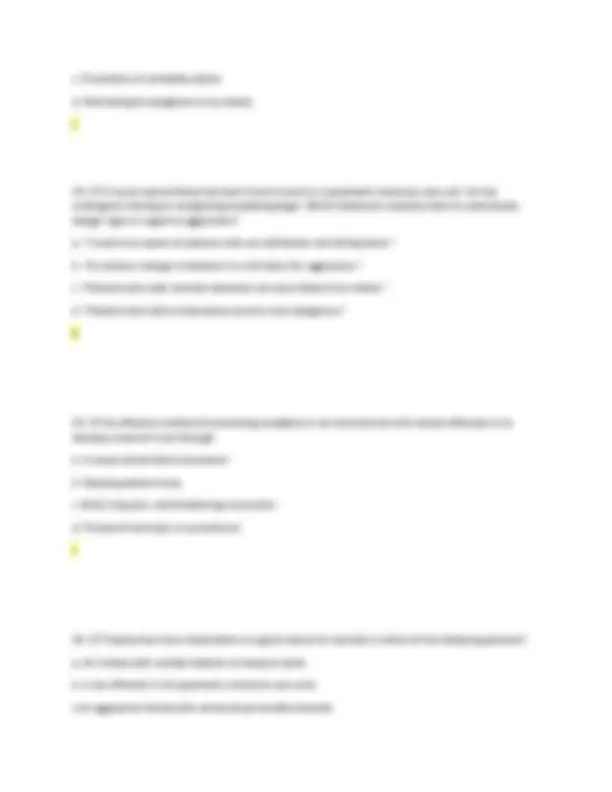
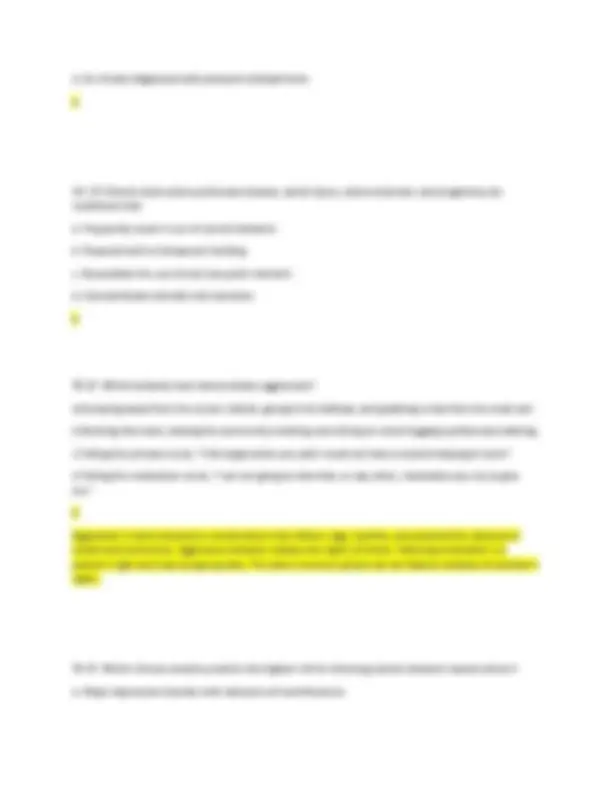
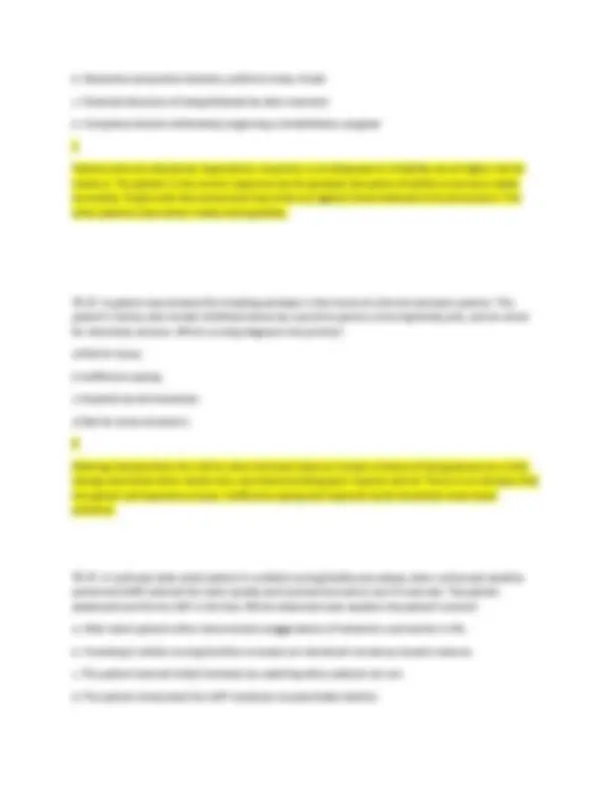
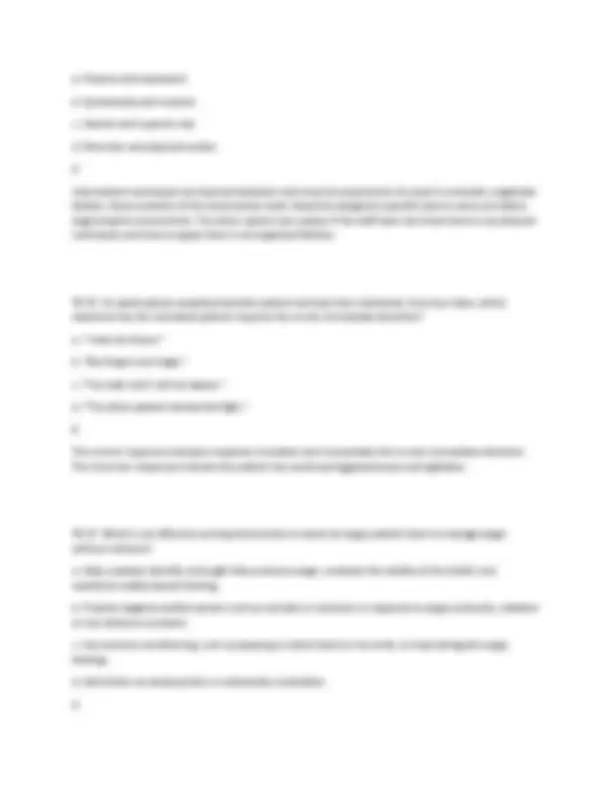

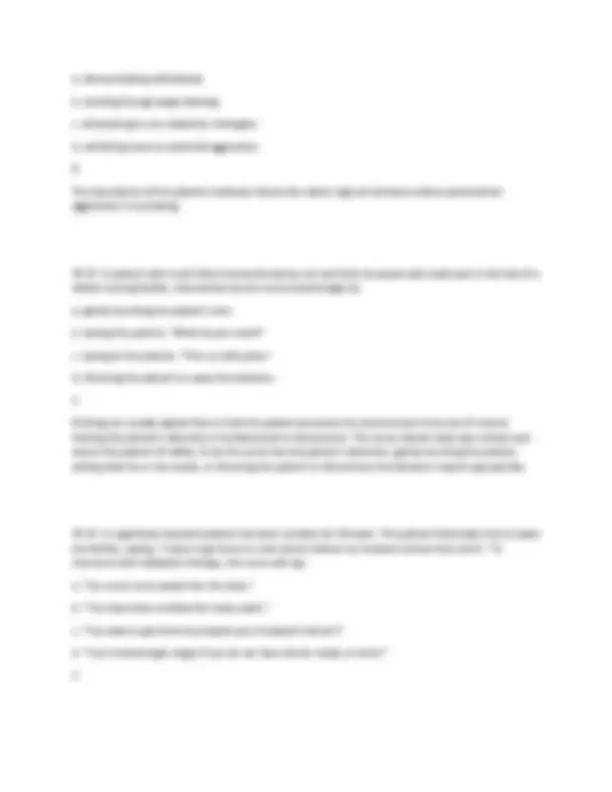
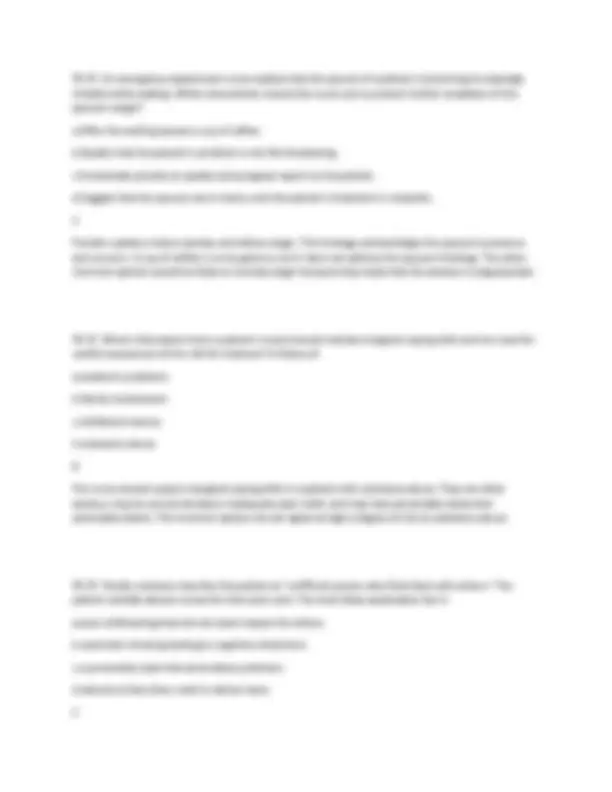
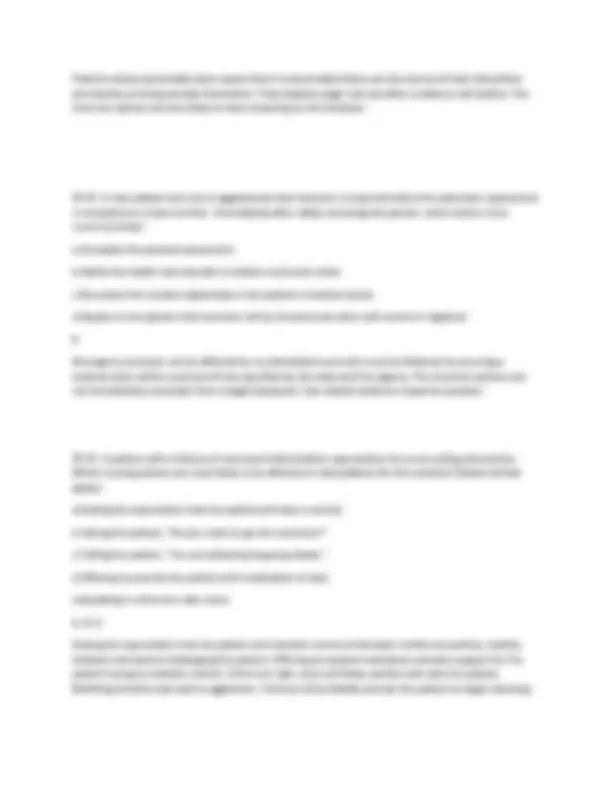
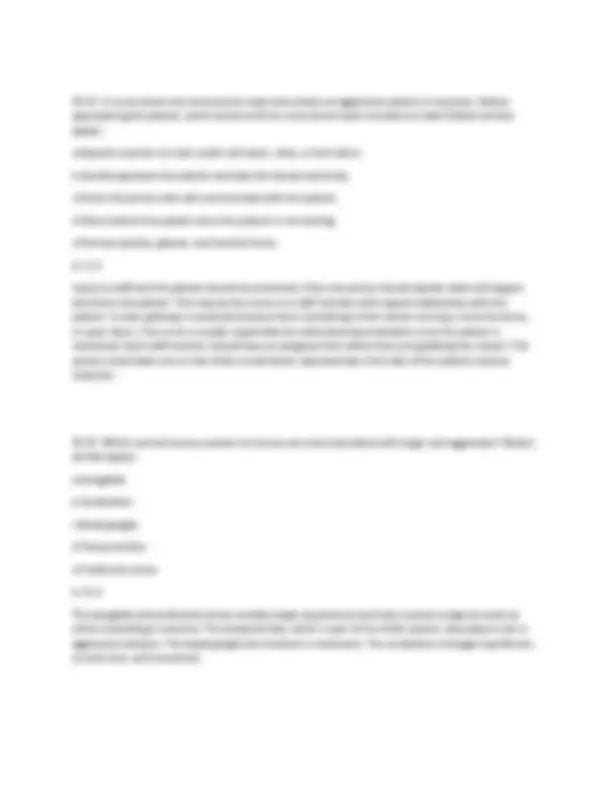
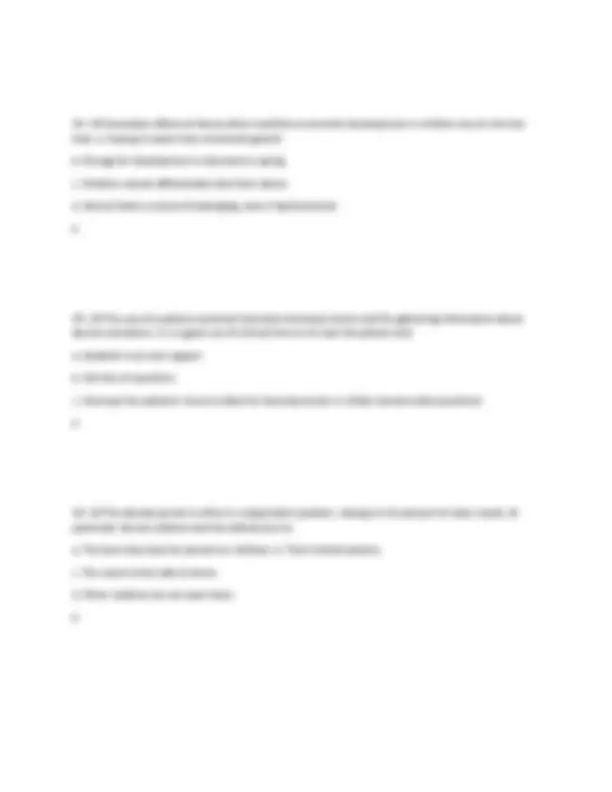
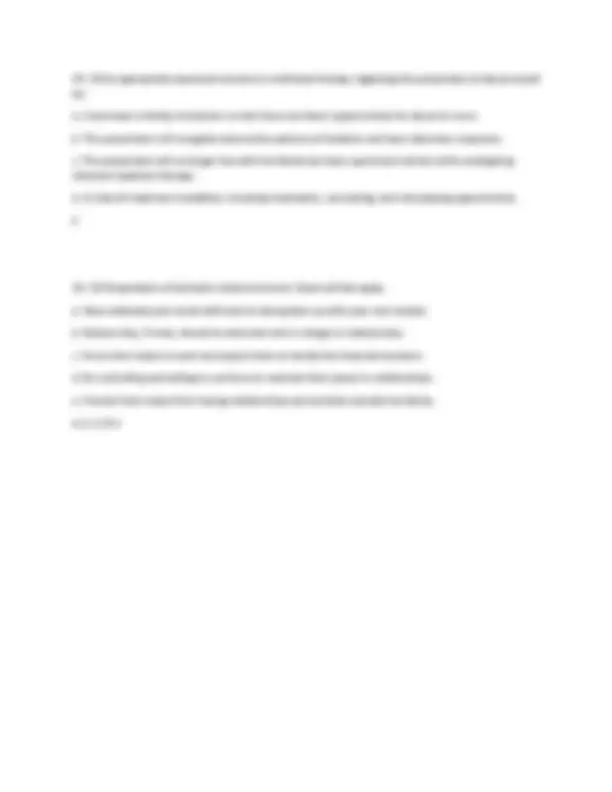


Study with the several resources on Docsity

Earn points by helping other students or get them with a premium plan


Prepare for your exams
Study with the several resources on Docsity

Earn points to download
Earn points by helping other students or get them with a premium plan
Community
Ask the community for help and clear up your study doubts
Discover the best universities in your country according to Docsity users
Free resources
Download our free guides on studying techniques, anxiety management strategies, and thesis advice from Docsity tutors
NSG-3450 Mental Health Exam 4 (Latest Update) Questions and Answers (100% Guaranteed Pass)
Typology: Exams
1 / 19

This page cannot be seen from the preview
Don't miss anything!












CH. 27 Which individuals are most at risk for displaying aggressive behavior? Select all that apply. a. An adolescent embarrassed in front of friends. b. A young male who feels rejected by the social group. c. A young adult depressed after the death of a friend. d. A middle-aged adult who feels that concerns are going unheard. e. A patient who was discovered telling a lie. a,b,d,e CH. 27 A newly admitted male patient has a long history of aggressive behavior toward staff. Which statement by the nurse demonstrates the need for more information about the use of restraint? a. "If his behavior warrants restraints, someone will stay with him the entire time he's restrained." b. "I'll call the primary provider and get an as needed (prn) seclusion/restraint order." c. "If he is restrained, be sure he is offered food and fluids regularly."d. "Remember that physical restraints are our last resort." b CH. 27 Which intervention(s) should the nurse implement when helping a patient expresses anger in an inappropriate manner? Select all that apply. a. Approach the patient in a calm, reassuring manner. b. Provide suggestions regarding acceptable ways of communicating anger. c. Warn the patient that being angry is not a healthy emotional state. d. Set limits on the angry behavior that will be tolerated.
e. Allow any expression of anger as long as no one is hurt. a,b,d CH. 27 Which guidelines should direct nursing care when deescalating an angry patient? Select all that apply. a. Intervene as quickly as possible b. Identify the trigger for the anger c. Behave calmly and respectfully d. Recognize the patient's need for increased personal space e. Demands are agreed to as long as they won't result in harm to anyone a,b,c,d CH. 27 Which comorbid condition would result in cautious use of a selective serotonin reuptake inhibitors for a patient with chronic aggression? a. Asthma b. Anxiety disorder c. Glaucoma d. Bipolar disorder d CH. 27 John Patrick is a widower with four daughters. He has enjoyed a healthy relationship with all of them until they reached puberty. As each girl began to mature physically, he acted in an aggressive manner, beating her without provocation. John Patrick is most likely acting on: a. Self-protective measures b. Stress of raising four daughters
d. An inmate diagnosed with paranoid schizophrenia a CH. 27 Chronic obstructive pulmonary disease, spinal injury, seizure disorder, and pregnancy are conditions that: a. Frequently result in out of control behavior. b. Respond well to therapeutic holding. c. Necessitate the use of only two-point restraint. d. Contraindicate restraint and seclusion. d TB 27. Which behavior best demonstrates aggression? a.Stomping away from the nurses' station, going to the hallway, and grabbing a tray from the meal cart. b.Bursting into tears, leaving the community meeting, and sitting on a bed hugging a pillow and sobbing. c.Telling the primary nurse, "I felt angry when you said I could not have a second helping at lunch." d.Telling the medication nurse, "I am not going to take that, or any other, medication you try to give me." A Aggression is harsh physical or verbal action that reflects rage, hostility, and potential for physical or verbal destructiveness. Aggressive behavior violates the rights of others. Refusing medication is a patient's right and may be appropriate. The other incorrect options do not feature violation of another's rights. TB 27. Which clinical scenario predicts the highest risk for directing violent behavior toward others? a. Major depressive disorder with delusions of worthlessness
b. Obsessive-compulsive disorder; performs many rituals c. Paranoid delusions of being followed by alien monsters d. Completed alcohol withdrawal; beginning a rehabilitation program C Patients who are delusional, hyperactive, impulsive, or predisposed to irritability are at higher risk for violence. The patient in the correct response has the greatest disruption of ability to perceive reality accurately. People who feel persecuted may strike out against those believed to be persecutors. The other patients have better reality-testing ability. TB 27. A patient was arrested for breaking windows in the home of a former domestic partner. The patient's history also reveals childhood abuse by a punitive parent, torturing family pets, and an arrest for disorderly conduct. Which nursing diagnosis has priority? a.Risk for injury b.Ineffective coping c.Impaired social interaction d.Risk for other-directed v D Defining characteristics for risk for other-directed violence include a history of being abused as a child, having committed other violent acts, and demonstrating poor impulse control. There is no indicator that the patient will experience injury. Ineffective coping and impaired social interaction have lower priorities. TB 27. A confused older adult patient in a skilled nursing facility was asleep when unlicensed assistive personnel (UAP) entered the room quietly and touched the bed to see if it was wet. The patient awakened and hit the UAP in the face. Which statement best explains the patient's action? a. Older adult patients often demonstrate exaggerations of behaviors used earlier in life. b. Crowding in skilled nursing facilities increases an individual's tendency toward violence. c. The patient learned violent behavior by watching other patients act out. d. The patient interpreted the UAP's behavior as potentially harmful.
TB 27. An intramuscular dose of antipsychotic medication needs to be administered to a patient who is becoming increasingly more aggressive and refused to leave the day room. The nurse should enter the day room a. and say, "Would you like to come to your room and take some medication your health care provider prescribed for you?" b. accompanied by three staff members and say, "Please come to your room so I can give you some medication that will help you regain control." c. and place the patient in a basket-hold and then say, "I am going to take you to your room to give you an injection of medication to calm you." d. accompanied by a male security guard and tell the patient, "Come to your room willingly so I can give you this medication, or the guard and I will take you there." B A patient gains feelings of security if he or she sees others are present to help with control. The nurse gives a simple direction, honestly states what is going to happen, and reassures the patient that the intervention will be helpful. This positive approach assumes the patient can act responsibly and will maintain control. Physical control measures are used only as a last resort. TB 27. After an assault by a patient, a nurse has difficulty sleeping, startles easily, and is preoccupied with the incident. The nurse said, "That patient should not be allowed to get away with that behavior." Which response poses the greatest barrier to the nurse's ability to provide therapeutic care? a. Startle reactions b.Difficulty sleeping c. A wish for revenge d. Preoccupation with the incident C The desire for revenge signals an urgent need for professional supervision to work through anger and counter the aggressive feelings. Feelings of revenge create a risk for harm to the patient. The distracters are normal in a person who was assaulted. They usually are relieved with crisis intervention, help the individual regain a sense of control, and make sense of the event. TB 27. The staff development coordinator plans to teach use of physical management techniques for use when patients become assaultive. Which topic should the coordinator emphasize?
a. Practice and teamwork b. Spontaneity and surprise c. Caution and superior size d. Diversion and physical outlets A Intervention techniques are learned behaviors and must be practiced to be used in a smooth, organized fashion. Every member of the intervention team should be assigned a specific task to carry out before beginning the intervention. The other options are useless if the staff does not know how to use physical techniques and how to apply them in an organized fashion. TB 27. An adult patient assaulted another patient and was then restrained. One hour later, which statement by the restrained patient requires the nurse's immediate attention? a. "I hate all of you!" b. "My fingers are tingly." c. "You wait until I tell my lawyer." d. "The other patient started the fight." B The correct response indicates impaired circulation and necessitates the nurse's immediate attention. The incorrect responses indicate the patient has continued aggressiveness and agitation. TB 27. Which is an effective nursing intervention to assist an angry patient learn to manage anger without violence? a. Help a patient identify a thought that produces anger, evaluate the validity of the belief, and substitute reality-based thinking. b. Provide negative reinforcement such as restraint or seclusion in response to angry outbursts, whether or not violence is present. c. Use aversive conditioning, such as popping a rubber band on the wrist, to help extinguish angry feelings. d. Administer an antipsychotic or antianxiety medication. A
a. demonstrating withdrawal. b. working though angry feelings. c. attempting to use relaxation strategies. d. exhibiting clues to potential aggression. D The description of the patient's behavior shows the classic signs of someone whose potential for aggression is increasing. TB 27. A patient with multi-infarct dementia lashes out and kicks at people who walk past in the hall of a skilled nursing facility. Intervention by the nurse should begin by a. gently touching the patient's arm. b. asking the patient, "What do you need?" c. saying to the patient, "This is a safe place." d. directing the patient to cease the behavior. C Striking out usually signals fear or that the patient perceives the environment to be out of control. Getting the patient's attention is fundamental to intervention. The nurse should make eye contact and assure the patient of safety. Once the nurse has the patient's attention, gently touching the patient, asking what he or she needs, or directing the patient to discontinue the behavior may be appropriate. TB 27. A cognitively impaired patient has been a widow for 30 years. This patient frantically tries to leave the facility, saying, "I have to go home to cook dinner before my husband arrives from work." To intervene with validation therapy, the nurse will say: a. "You must come away from the door." b. "You have been a widow for many years." c. "You want to go home to prepare your husband's dinner?" d. "Your husband gets angry if you do not have dinner ready on time?" C
Validation therapy meets the patient "where she or he is at the moment" and acknowledges the patient's wishes. Validation does not seek to redirect, reorient, or probe. The distracters do not validate the patient's feelings. TB 27. A patient with a history of anger and impulsivity was hospitalized after an accident resulting in multiple injuries. The patient loudly scolds nursing staff, "I'm in pain all the time but you don't give me medicine until YOU think it's time." Which nursing intervention would best address this problem? a. Teach the patient to use coping strategies such as deep breathing and progressive relaxation to reduce the pain. b. Talk with the health care provider about changing the pain medication from prn to patient-controlled analgesia. c. Tell the patient that verbal assaults on nurses will not shorten the wait for analgesic medication. d. Talk with the patient about the risks of dependency associated with overuse of analgesic medication. B Use of patient-controlled analgesia will help the patient manage the pain. This intervention will help reduce the patient's anxiety and anger. Dependency is not an important concern related to acute pain. TB 27. A patient has a history of impulsively acting-out anger by striking others. Select the most appropriate intervention for avoiding similar incidents. a. Teach the patient about herbal preparations that reduce anger. b. Help the patient identify incidents that trigger impulsive anger. c. Explain that restraint and seclusion will be used if violence occurs. d. Offer one-on-one supervision to help the patient maintain control. B Identification of trigger incidents allows the patient and nurse to plan interventions to reduce irritation and frustration, which lead to acting-out anger, and eventually to put into practice more adaptive coping strategies.
TB 27. An emergency department nurse realizes that the spouse of a patient is becoming increasingly irritable while waiting. Which intervention should the nurse use to prevent further escalation of the spouse's anger? a.Offer the waiting spouse a cup of coffee. b.Explain that the patient's condition is not life threatening. c.Periodically provide an update and progress report on the patient. d.Suggest that the spouse return home until the patient's treatment is complete. C Periodic updates reduce anxiety and defuse anger. This strategy acknowledges the spouse's presence and concern. A cup of coffee is a nice gesture, but it does not address the spouse's feelings. The other incorrect options would be likely to increase anger because they imply that the anxiety is inappropriate. TB 27. Which information from a patient's record would indicate marginal coping skills and the need for careful assessment of the risk for violence? A history of a.academic problems. b.family involvement. c.childhood trauma. d.substance abuse. D The nurse should suspect marginal coping skills in a patient with substance abuse. They are often anxious, may be concerned about inadequate pain relief, and may have personality styles that externalize blame. The incorrect options do not signal as high a degree of risk as substance abuse. TB 27. Family members describe the patient as "a difficult person who finds fault with others." The patient verbally abuses nurses for their poor care. The most likely explanation lies in a.poor childrearing that did not teach respect for others. b.automatic thinking leading to cognitive distortions. c.a personality style that externalizes problems. d.delusions that others wish to deliver harm. C
Patients whose personality style causes them to externalize blame see the source of their discomfort and anxiety as being outside themselves. They displace anger and are often unable to self-soothe. The incorrect options are less likely to have a bearing on this behavior. TB 27. A new patient acts out so aggressively that seclusion is required before the admission assessment is completed or orders written. Immediately after safely secluding the patient, which action is the nurse's priority? a.Complete the physical assessment. b.Notify the health care provider to obtain a seclusion order. c.Document the incident objectively in the patient's medical record. d.Explain to the patient that seclusion will be discontinued when self-control is regained. B Emergency seclusion can be effected by a credentialed nurse but must be followed by securing a medical order within a period of time specified by the state and the agency. The incorrect options are not immediately necessary from a legal standpoint. See related audience response question. TB 27. A patient with a history of command hallucinations approaches the nurse yelling obscenities. Which nursing actions are most likely to be effective in deescalation for this scenario? (Select all that apply.) a.Stating the expectation that the patient will stay in control. b.Asking the patient, "Do you want to go into seclusion?" c.Telling the patient, "You are behaving inappropriately." d.Offering to provide the patient with medication to help. e.Speaking in a firm but calm voice. A, D, E Stating the expectation that the patient will maintain control of behavior reinforces positive, healthy behavior and avoids challenging the patient. Offering as-needed medication provides support for the patient trying to maintain control. A firm but calm voice will likely comfort and calm the patient. Belittling remarks may lead to aggression. Criticism will probably prompt the patient to begin shouting.
TB 27. Because an intervention was required to control a patient's aggressive behavior, the nurse plans a critical incident debriefing with staff members. Which topics should be the primary focus of this discussion? (Select all that apply.) a.Patient behaviors associated with the incident b.Genetic factors associated with aggression c.Intervention techniques used by the staff d.Effects of environmental factors e.Theories of aggression A, C, D The patient's behavior, the intervention techniques used, and the environment in which the incident occurred are important to establish realistic outcomes and effective nursing interventions. Discussing views about the theoretical origins of aggression would be less effective and relevant CH.28 Which statement made by a new mother should be explored further by the nurse? a. "I have three children, that's enough." b. "I think the baby cries just to make me angry." c. "I wish my husband could help more with the baby." d. "Babies are a blessing, but they are a lot of work." b CH. 28 Which problem is observed in children who regularly witness acts of violence in their family? Select all that apply. a. Phobias b. Low self-esteem c. Major depressive disorder d. Narcissistic personality disorder e. Posttraumatic stress disorder a, b, c, e
CH. 28 What situation associated with a caregiver presents the greatest risk that an older adult will experience abuse by that caregiver? a. The caregiver is a single male relative. b. The caregiver was neglected as a child. c. The caregiver is under the age of 30. d. The caregiver has little experience with the elderly. b CH. 28 What safety-related responsibility does the nurse have in any situation of suspected of abuse? a. Protect the patient from future abuse by the abuser. b. Inform the suspected abuser that the authorities have been notified. c. Arrange for counseling for all involved parties but especially the patient. d. Report suspected abuse to the proper authorities. d CH. 28 The nurse is assisting a patient to identify safety issues that may occur now that she has left an abusive partner. What telephone numbers should be available to the patient? Select all that apply. a. The police department b. An abuse hotline c. A responsible friend or family member d. A domestic violence shelter e. The hospital emergency department a,b,c,d
CH. 28 An appropriate expected outcome in individual therapy regarding the perpetrator of abuse would be: a. A decrease in family interaction so that there are fewer opportunities for abuse to occur. b. The perpetrator will recognize destructive patterns of behavior and learn alternate responses. c. The perpetrator will no longer live with the family but have supervised contact while undergoing intensive inpatient therapy. d. A triad of treatment modalities, including medication, counseling, and role-playing opportunities. b CH. 28 Perpetrators of domestic violence tend to: Select all that apply. a. Have relatively poor social skills and to have grown up with poor role models. b. Believe they, if male, should be dominant and in charge in relationships. c. Force their mates to work and expect them to handle the financial decisions. d. Be controlling and willing to use force to maintain their power in relationships. e. Prevent their mates from having relationships and activities outside the family. a, b, d, & e